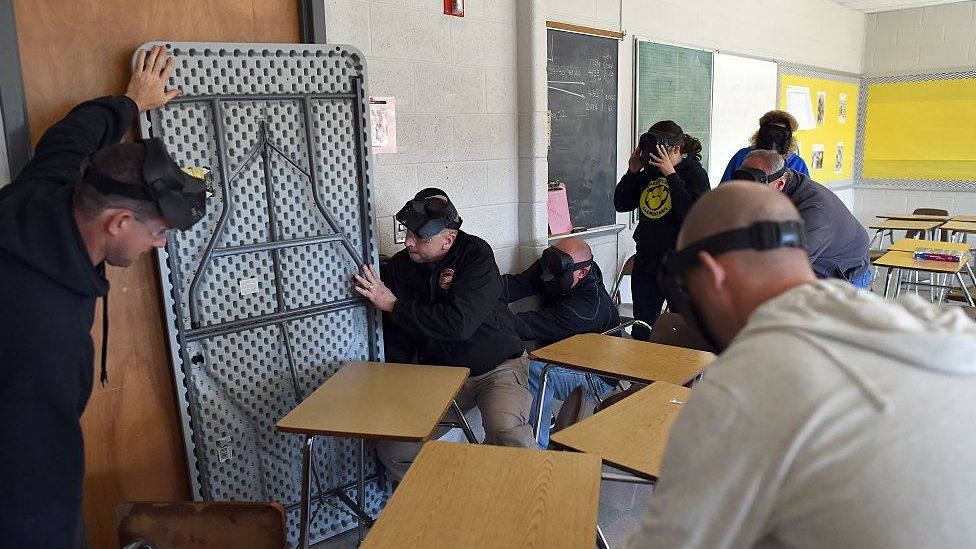Is ‘Run, Hide, Fight’ the best advice for mass shootings?
- Published

When a gunman opened fire at Michigan State University on Monday, students on campus received a three-word order: "Run, Hide, Fight."
"Run means evacuate away from danger if you can do so safely, Hide means to secure-in-place, and Fight means protect yourself if no other option," the text message from the university read.
Three students were killed and five were injured in the attack in East Lansing, Michigan. A 43-year-old suspect who had no ties to the university later died of a self-inflicted gunshot wound.
The university's message was part of a government-funded active-shooting programme that is provided to students in the US. It sparked an emotional response from those who lamented the fact that a place of education would need to share the advice in the first place, and from some who questioned whether students should be told to fight at all.
"Nothing is surprising anymore, but still I'm struggling to wrap my head around a school encouraging its students to 'Run, Hide, Fight.' What an American reality," one user wrote on Twitter. Many other shared similar reactions.
But active shooting and criminology experts told the BBC the message was not designed to encourage people to try to tackle attackers. Instead, they said it was an important way to remind people of the best options for their survival.
'Fighting is a last resort'
"It's three simple verbs that trigger the memory of the training you received, and which tell you that fighting is a last resort and running is a good first resort," said Katherine Schweit, a retired FBI agent. Ms Schweit helped adapt the Run, Hide, Fight training into a government programme following the 2012 shooting at Sandy Hook Elementary School in Newtown, Connecticut.
Reports of heroic bystanders stepping in to halt gun attacks have proliferated in recent years. Most recently, 26-year-old Brandon Tsay disarmed a gunman who killed 11 people at a Lunar New Year celebration in Monterey Park, California.
But over the past two decades, it's been extremely rare for mass shootings to be stopped by a bystander.
In most cases - around 60% of the time - attackers are either killed by police or die by suicide at the scene of the crime, according to Alex del Carmen, an associate dean at Tarleton State University's School of Criminology, Criminal Justice and Public Administration.
Of those instances, the gunman took their own life 65% of the time, according to Dr del Carmen, whose team has reviewed data on 178 mass shootings that occurred between 1966 and May 2021.
Not all countries have adapted the same advice as the US, where mass shootings are much more common than in any other nation. In the UK, for instance, police use the three-word message "Run, Hide, Tell" in the event of a firearms or weapons-based attack.
But the US government's "Run, Hide, Fight" training is in line with an "option-based" active shooter response strategy, which is the most effective way to save lives, according to JP Guilbault, chief executive officer at Navigate 360 which provides active shooter preparedness training.
Students around the world on US school shootings and their biggest fears
For some, depending on their age, capability and situation, fighting might not be an option at all, and analysing those variables while in a highly stressful situation can prove challenging, experts acknowledged.
But any noise or distraction a person can make to create time and distance when they are not able to run or hide and have come face to face with an attacker could increase their chance of survival, said Mr Guilbault.
'The new CPR training'
Still, that does not mean fighting works all the time, and it also does not mean it is the best general course of action because the data "simply isn't there yet", said Dr del Carmen.
He added that the "Run, Hide, Fight" messaging would be much more effective if students and school staff were given adequate response training, which he said many have not received.
"I know that some people check the box and say they have a plan in place, but are they really rehearsing it?" he asked.
Unfortunately, Mr Guilbault said such training had become the "next generation of CPR". "It's a new skill that everyone has to have," he said.
Contending with that reality, experts said, is a different matter.
"Nobody wants to have this happen," said Ms Schweit, who said the shooting at Michigan State University, her alma mater, on Monday hit close to home. "I am angry about the fact that I still have to be talking about this.
"But that's where we are right now."
- Published24 February 2023
- Published14 February 2023
- Published15 February 2023